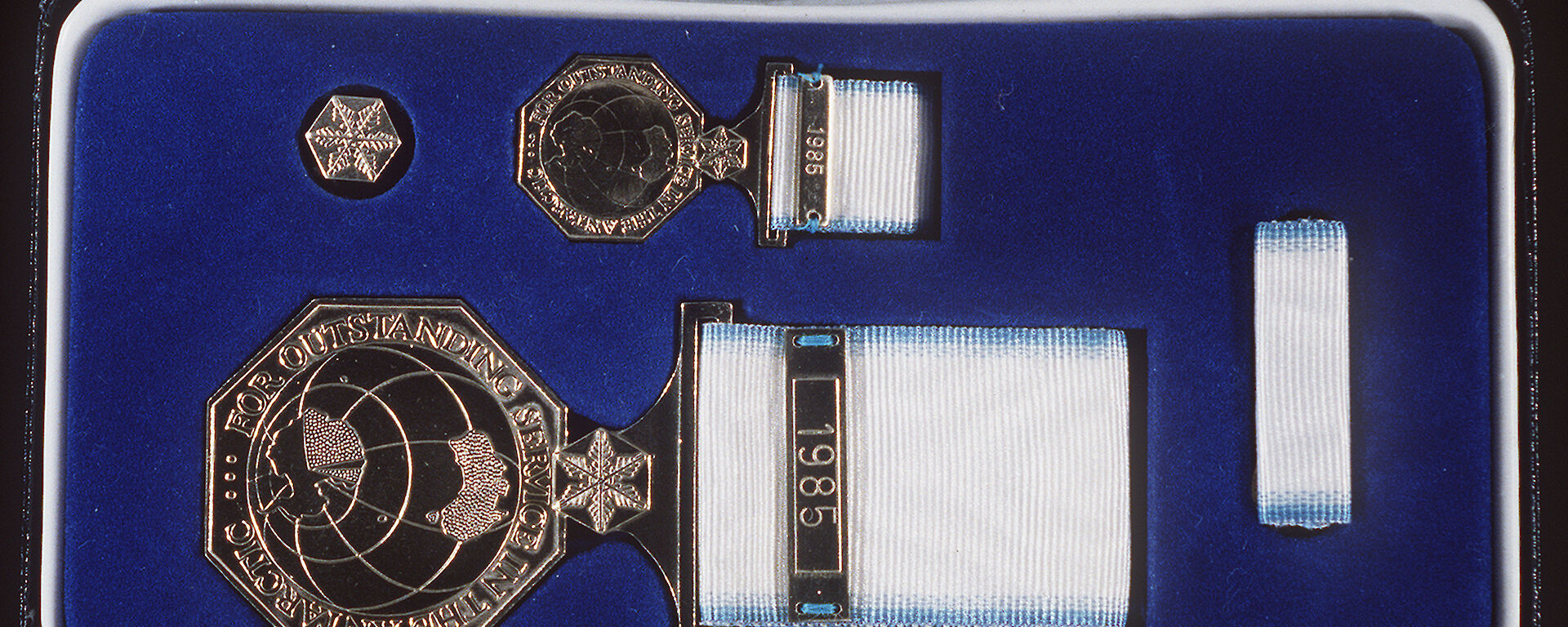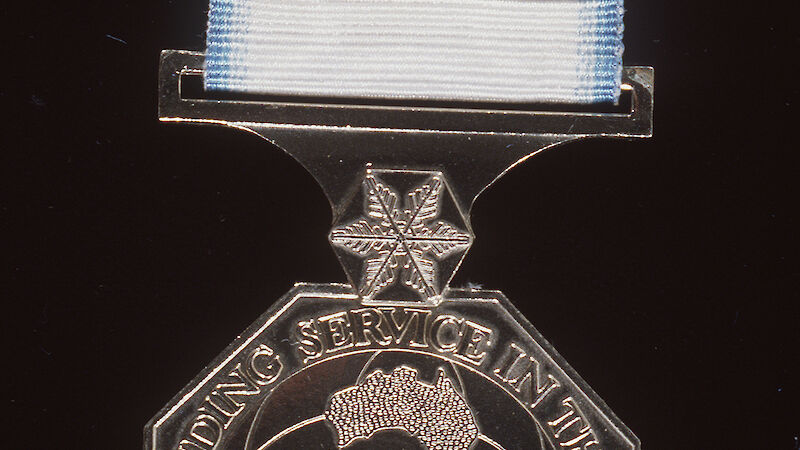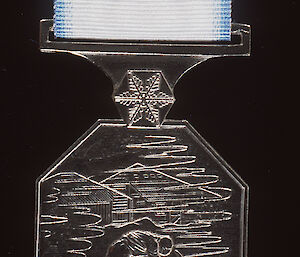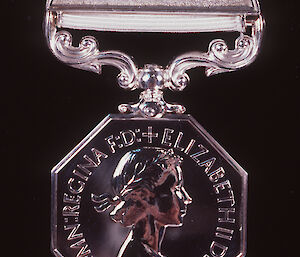The Australian Antarctic Medal, established in 1987, is an award in the Meritorious Service Awards category of the Australian Honours System. The Australian Antarctic Medal replaced the (British) Imperial Polar Medal and its variations which date back to 1857 for service in the Arctic and Antarctic regions.
Prior to 1982 there were two Australian committees set up by Ministerial appointment to cover the award of the Polar Medal and the naming of places and features in the Australian Antarctic Territory. The medal committee worked in close liaison with the Polar Medal committees of the United Kingdom and New Zealand to ensure that the standards being applied for awards of the medal were consistent between the three nations. 1982 saw the creation of a combined committee — the Australian Antarctic Names and Medal Committee — to administer both Antarctic place names and the Polar Medal.
The first meeting of the new committee, chaired by Sir Russel Madigan (son of Dr Cecil Thomas Madigan from the Australasian Antarctic Expedition) considered awards of the Polar Medal for the 1982 expedition year. However, shortly after coming to power on 11 March 1983, the first Hawke Ministry declared that the Australian Government would no longer recommend anyone for an Imperial award.
At its meeting on 3 December 1984, the Committee noted that the Government had agreed to examine a proposal for an Australian award for service in Polar Regions. The Committee agreed ‘that there should be an Australian Award to honour outstanding achievement in the Australian Antarctic Territory … (and) that the award could also be given for scientific achievement and exploration’.
There was some discussion about the design of the medal: ‘The medal shall be of silver and octagonal in shape, bearing on the obverse the Australian coat of arms and on the reverse a representation of the hut at Commonwealth Bay with a figure leaning on an ice-axe in the foreground’. This represented a departure from the Imperial medals in that the Sovereign’s head was not to form the obverse of the medal.
On Australia Day 1986 Prime Minister Bob Hawke announced that: ‘The Federal Government has agreed on a number of new awards to enhance and develop the Australian Honours System…They will include medals for exceptional service by Antarctic expeditioners’.
By this stage Mr Michael Tracey of Colonial Fine Arts Gallery, Queensland, had submitted several designs for the medal and the Committee decided that the obverse of the medal should be based on the current Antarctic Service Medallion; a map showing Australia and Antarctica.
It was agreed that the design should not include New Zealand or topography (as did the Service Medallion) but should identify the Australian Antarctic Territory clearly by stippling. The medal should be inscribed ‘For outstanding service in the Antarctic’ with the year or years of service shown on a clasp in the ribbon. Second and subsequent awards would be identified by placing an ice crystal pin on the ribbon when worn on uniform. The same ice crystal design would be used for a lapel badge to be worn by recipients.
There appeared to be some dissatisfaction with Mr Tracey’s designs and the Committee asked Mr Stuart Devlin to submit designs as well. Mr Devlin had designed the insignia for the Order of Australia as well as the decimal coinage. While Mr Tracey’s map was approved by the Minister for use on the obverse of the medal, the Committee decided to terminate Mr Tracey’s design involvement. Mr Devlin’s final design was submitted to the Minister and approved on 21 January 1987.
Some years later, in 1992, an article appeared in the Australian Coin Review which noted: ‘It is disappointing to record that the Medal is, like most Australian awards, poorly manufactured and unattractive… when compared to the Polar Medal, the Antarctic Medal, in the words of one of the recipients, “looks like a Woolworths job — the difference is like chalk and cheese”’.
On 2nd June 1987 Her Majesty the Queen signed the Letters Patent which established the ‘Antarctic Medal’, and on 22nd June the first recipients were announced. Sixteen awards were made, covering 1981 to 1986. Unfortunately, the medals were not finished in time for presentation, nor had the ribbon been manufactured — neither of these deficiencies were remedied until 1989.
The 1990 meeting of the Committee noted that the medal had finally been minted and that investitures were held around Australia. Sir Russel Madigan and Dr Phillip Law (the Director of the Australian Antarctic Division from 1947–1966) attended the Melbourne ceremony.
The 1996 meeting of the Committee was held at the Australian Antarctic Division’s headquarters in Tasmania for the first time. The Committee noted the proposal that the Antarctic Medal be re-named the ‘Australian Antarctic Medal’ and that all recipients of the medal would be granted the post-nominal letters AAM.
In 2003, Parliamentary Secretary Dr Sharman Stone, permitted the Committee to nominate candidates for the medal if, in its opinion, the nominations provided to it did not measure up to the requirements. This move recognised that the strength or weakness of an Honour depended on the quality of nominations it received.
By 2011 the regulations for the Honour had been widened to enable the medal to be granted to Australian scientists or supporting officers attached to scientific research expeditions undertaken by other Treaty Nations; providing, of course, that the normal requirements of the medal were met.
Unique among the Meritorious Service Awards, the Australian Antarctic Medal can be awarded to the same person for a second and subsequent occasion, and there is no quota imposed on the number of awards per year. The medal can be awarded posthumously and it may also be withdrawn.
Any person may nominate an expeditioner for the award of the medal and all recommendations are considered by the Australian Antarctic Names and Medal Committee. The Committee makes recommendations to the responsible Minister or Parliamentary Secretary who then provides his or her recommendations to the Governor-General by the end of May each year. The Governor-General announces the awards in a special Honours List on Midwinter’s Day (21 June); a time of traditional significance to all who have worked in the Antarctic.
Except in exceptional circumstances, the recipient of a medal will have worked for not less than 12 months (may be an aggregate) in the Antarctic climate south of latitude 60° south, or elsewhere in the Antarctic region where ‘the rigours of Antarctic climate and terrain prevail’.
2012 was a significant year in that it saw the first award of an additional clasp being made — to Australian Antarctic Division seabird ecologist Dr Graham Robertson — and the first posthumous award to the late Dr Neil Adams of the Bureau of Meteorology (Australian Antarctic Magazine 23: 33-34, 2012). It also saw the first award of the medal to a person under the ‘special circumstances’ clause – to Dr James Doube for his outstanding contributions to polar medicine. Dr Doube had not wintered below 60° south, but had spent two winters at Macquarie Island. These high notes ended the first 25 years of the Australian Antarctic Medal.
More information about the Australian Antarctic Medal.
Joe Johnson
Chair, Australian Antarctic Names and Medal Committee





